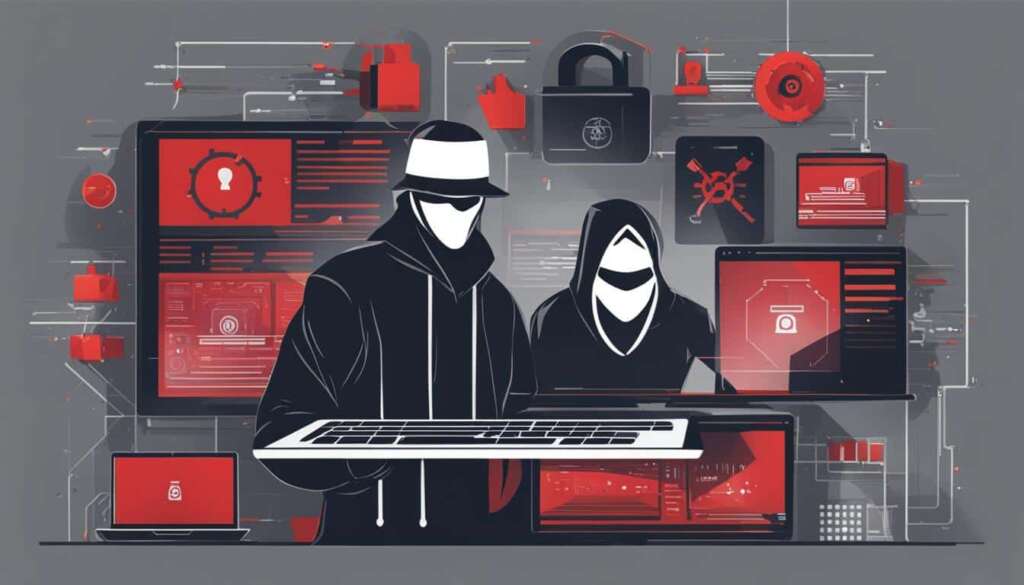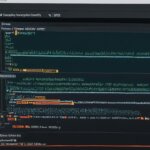Table of Contents
A hacker is an individual who uses their computer, networking, or other technical skills to overcome a technical problem. However, the term hacker is often associated with individuals who use their skills to gain unauthorized access to systems or networks in order to commit crimes. The term hacker was first used in the 1960s to describe a programmer who could increase the efficiency of computer code by removing excess machine code instructions.
There are different types of hackers, including ethical hackers, who use their skills to identify and fix security vulnerabilities, and threat actors, who intentionally gain unauthorized access for malicious purposes. Hacking techniques include phishing, viruses and malicious code, user interface redress, DoS and DDoS attacks, DNS cache poisoning, SQL injection, keylogger injection, and brute-force attacks.
Some famous hackers include Anonymous, Jonathan James, and Adrian Lamo.
In this article, we will explore the concept of hacking, the different types of hackers, common hacking techniques, and some famous hackers. Whether you want to learn more about hackers and their activities or are interested in pursuing a career in ethical hacking, this guide will provide you with valuable insights and facts.
What is a Hacker?
A hacker is an individual who uses their computer, networking, or other technical skills to overcome a technical problem. The term hacker can also refer to someone who gains unauthorized access to systems or networks to commit crimes, such as stealing information for identity theft or bringing down a system to collect a ransom. Hackers may use their abilities to hurt people or hold systems hostage. The term hacker has historically been divisive, used to describe individuals with a high degree of technical skill and creativity, as well as those who use their skills for illegal or unethical purposes. The term has evolved to encompass individuals with advanced understanding of computers, networking, programming, or hardware.
Unauthorized access is one of the key elements associated with hackers. It involves gaining entry into systems or networks without proper authorization, often breaching security measures to access sensitive information or resources. Unauthorized access can have severe consequences, leading to data breaches, identity theft, and financial loss. Hackers who engage in unauthorized access often exploit vulnerabilities in computers, networks, or software to bypass security controls and gain entry.
Identity Theft
Identity theft is a significant concern associated with hackers. When hackers gain unauthorized access to systems or networks, they can potentially steal personal and sensitive information, such as social security numbers, credit card details, or passwords. This stolen information can be used to assume someone’s identity and carry out fraudulent activities, such as making unauthorized purchases, opening fraudulent accounts, or causing reputational damage. The consequences of identity theft can be far-reaching, impacting individuals’ financial stability and personal well-being.
System Disruption
Hackers are sometimes motivated by the desire to disrupt systems and cause chaos. They may deploy various techniques, such as deploying malware, launching distributed denial-of-service (DDoS) attacks, or exploiting vulnerabilities to bring down systems or networks. System disruptions can lead to significant financial losses, interruption of services, and reputational damage for organizations. Hackers who engage in system disruption often do so for personal gain, political motivations, or to showcase their technical skills and capabilities.
Unauthorized access, identity theft, and system disruption are all part of the hacker’s toolkit, allowing them to exploit vulnerabilities and gain control over computers, networks, and data.” – Cybersecurity Expert
| Hacker Actions | Purpose |
|---|---|
| Unauthorized Access | Gain entry to systems or networks without authorization |
| Identity Theft | Steal personal information for fraudulent activities |
| System Disruption | Interrupt services or cause chaos for personal gain or political motivations |
How does Hacking Work?
Hackers utilize their technical skills to exploit cybersecurity vulnerabilities and gain unauthorized access to computers, networks, or other IT systems. The hacking process involves various techniques aimed at stealing sensitive information or disrupting an organization’s services. Ethical hackers, also known as pen testers, engage in hacking as a profession or hobby with the goal of identifying security weaknesses and advising companies on improving their defenses. On the other hand, malicious hackers focus on stealing login credentials, financial data, and other valuable information.
Hackers can exploit both technical and social weaknesses to achieve their objectives. Technical weaknesses include vulnerabilities in software, hardware, or network infrastructure that can be manipulated to gain unauthorized access. Social weaknesses involve manipulating individuals through tactics such as social engineering or phishing.
Once hackers gain access, they can take various actions, including:
- Installing malware: Hackers may deploy malicious software to compromise the targeted system, steal sensitive data, or disrupt its operations.
- Stealing or destroying data: Accessing and pilfering valuable information, or intentionally deleting or corrupting data to cause harm.
- Disrupting services: Hackers can launch DoS (Denial of Service) or DDoS (Distributed Denial of Service) attacks to overwhelm systems with traffic, rendering them inaccessible to legitimate users.
Hackers actively participate in forums to exchange information and enhance their hacking skills. These forums can serve as platforms for both ethical hackers and criminal hackers. The dark web hosts underground communities where hackers share knowledge, tools, and data related to illegal hacking activities.
“Ethical hackers, also known as pen testers, engage in hacking as a profession or hobby and aim to gain unauthorized access to computers, networks, or other IT systems.”
Understanding how hacking works is crucial for businesses and individuals to protect themselves against cyber threats. By staying informed about hacking techniques and cybersecurity vulnerabilities, organizations can employ strategies and implement robust security measures to safeguard their sensitive information and digital assets.

Types of Hackers
Understanding the different types of hackers is crucial in navigating the complex landscape of cybersecurity. Hackers come in various forms, each with their own motivations and actions. Let’s explore some of the key categories:
Ethical Hackers
Ethical hackers, also known as white hat hackers, work in the public’s best interest and help organizations improve their security. They use their skills to identify vulnerabilities and then report them to the relevant parties for proper remediation. Ethical hackers play a vital role in ensuring the integrity of systems and protecting sensitive information.
Unauthorized Hackers
Unauthorized hackers, also known as black hat hackers, operate with malicious intent. They gain unauthorized access to networks or systems with the aim of causing harm, stealing valuable information, or exploiting vulnerabilities for personal gain. Such hackers engage in illegal activities and pose a significant threat to individuals and organizations.
Gray Hat Hackers
Gray hat hackers fall somewhere between ethical and unauthorized hackers. They access systems without proper authorization but often refrain from causing unnecessary damage. Gray hat hackers may exploit vulnerabilities to expose weaknesses and encourage organizations to improve their security measures. Although their intentions are not purely ethical, they aim to bring attention to security flaws rather than cause harm.
Red Hat Hackers
Red hat hackers, also known as vigilante hackers, take it upon themselves to stop malicious hackers. They use unconventional and sometimes aggressive methods to disrupt the activities of unauthorized individuals or groups. Red hat hackers operate outside the boundaries of the law, motivated by their desire to protect innocent users and combat cybercrime.
Blue Hat Hackers
Blue hat hackers use hacking techniques as a form of revenge. Motivated by personal reasons, they may utilize their skills to target specific individuals or organizations that they feel have wronged them. Blue hat hackers seek to cause damage or inconvenience as a means of retribution or retaliation.
Script Kiddies
Script kiddies are amateur hackers who rely on pre-written scripts or tools to carry out their attacks. They have limited technical skills and understanding but attempt to exploit vulnerabilities using readily available resources. Script kiddies often lack the expertise and knowledge to launch complex or sophisticated attacks, instead relying on existing tools to carry out their activities.
Hacktivists
Hacktivists are organizations or groups of hackers who carry out cyber attacks for politically motivated purposes. They use hacking techniques to promote their message, demand change, or influence public opinion. Hacktivist activities often intersect with social and political movements, seeking to bring attention to specific causes or societal issues.
Understanding the different types of hackers provides valuable insights into their motivations and actions. It also highlights the importance of ethical hacking in the ongoing battle against cyber threats.
Common Hacking Techniques
Hackers employ various techniques to exploit vulnerabilities and gain unauthorized access to systems and networks. Understanding these hacking techniques is crucial for individuals and organizations looking to protect themselves from cyber threats.
1. Phishing
Phishing is a technique where hackers create fraudulent emails or websites that masquerade as legitimate entities to trick users into revealing personal information, such as passwords or credit card details. It is important to be cautious when providing sensitive information online and to verify the authenticity of emails and websites.
2. Viruses and Malicious Code
Viruses and malicious code, such as worms and Trojan horses, are inserted into website files or software programs to gain unauthorized access to user data or control over a system. These malicious programs can spread rapidly and cause significant damage. It is essential to keep antivirus software up to date and exercise caution when downloading files or visiting unfamiliar websites.
3. User Interface Redress (Clickjacking)
User interface redress, also known as clickjacking, involves creating transparent or hidden elements on legitimate webpages that trick users into interacting with them, thereby gaining access to their computers or performing actions without their knowledge. By disguising malicious links or buttons as harmless elements, hackers can deceive users into executing unintended actions.
4. DoS and DDoS Attacks
DoS (Denial of Service) and DDoS (Distributed Denial of Service) attacks aim to disrupt computer systems or networks by overwhelming them with an excessive amount of traffic. This flood of traffic prevents legitimate users from accessing the target system or network. DoS attacks are typically carried out by a single source, while DDoS attacks involve multiple compromised devices.
5. SQL Injection
SQL (Structured Query Language) injection is a technique where hackers exploit vulnerabilities in a web application’s database layer by injecting malicious SQL code into input fields. This allows them to manipulate the database and potentially gain unauthorized access to sensitive information or even modify the database’s content.
6. Keylogger Injection
Keylogger injection involves the installation of software or hardware that secretly records keystrokes on a user’s computer. This technique allows hackers to gather sensitive information, such as login credentials or credit card details, by capturing everything a user types. It is important to have reliable antivirus software and regularly scan for malware to protect against keylogger attacks.
7. Brute-Force Attacks
Brute-force attacks involve automated tools that systematically guess username and password combinations until they find the correct credentials to gain unauthorized access to a system or network. These attacks rely on the assumption that weak or easily guessable passwords are used. Implementing strong, unique passwords and enabling two-factor authentication can mitigate the risk of brute-force attacks.
| Hacking Technique | Description |
|---|---|
| Phishing | Creating fraudulent emails or websites to deceive users into revealing personal information. |
| Viruses and Malicious Code | Inserting harmful code into website files or software programs to gain unauthorized access to user data or control. |
| User Interface Redress (Clickjacking) | Tricking users into interacting with hidden or transparent elements on legitimate webpages. |
| DoS and DDoS Attacks | Overwhelming computer systems or networks with excessive traffic, causing disruption. |
| SQL Injection | Exploiting vulnerabilities in web applications’ database layer to gain unauthorized access or manipulate data. |
| Keylogger Injection | Recording keystrokes on a user’s computer to gather sensitive information. |
| Brute-Force Attacks | Using automated tools to systematically guess username and password combinations. |
Famous Hackers
While many famous technologists have been considered hackers, it is often threat actors who gain notoriety in mainstream accounts. Anonymous is a group of hackers known for encouraging civil disobedience through DoS attacks and other methods.
Jonathan James gained notoriety for hacking into government websites and stealing software code as a teenager. Adrian Lamo hacked into several high-profile organizations and was eventually arrested. However, notable technologists such as Donald Knuth, Ken Thompson, Vinton Cerf, Steve Jobs, and Bill Gates have also been associated with hacking, although they may have used their skills for legal purposes.
| Famous Hackers | Description |
|---|---|
| Anonymous | A group of hackers known for encouraging civil disobedience through DoS attacks and other methods. |
| Jonathan James | Gained notoriety for hacking into government websites and stealing software code as a teenager. |
| Adrian Lamo | Hacked into several high-profile organizations and was eventually arrested. |
| Donald Knuth | A well-known technologist associated with hacking. |
| Ken Thompson | A well-known technologist associated with hacking. |
| Vinton Cerf | A well-known technologist associated with hacking. |
| Steve Jobs | A well-known technologist associated with hacking. |
| Bill Gates | A well-known technologist associated with hacking. |
How to Become an Ethical Hacker
Becoming an ethical hacker requires a curious mind, coding skills, and a strong sense of ethics. To excel in this field, it is essential to have knowledge of networks, operating systems, programming languages, and information security principles. There are various educational pathways that can lead to a successful career as an ethical hacker.
One option is to pursue a degree in computer science or information technology, which provides a solid foundation in the technical aspects of the field. Alternatively, individuals can opt for independent study, online courses, or participation in boot camps that offer in-depth training in ethical hacking.
Obtaining relevant certifications also plays a crucial role in becoming an ethical hacker. The Certified Ethical Hacker (CEH) certification and the Offensive Security Certified Professional (OSCP) certification are highly regarded in the industry and demonstrate proficiency in ethical hacking skills.
There are numerous learning resources available for aspiring ethical hackers. Online platforms such as edX offer courses focused on cybersecurity and hacking techniques, while boot camps like the University of Denver Cybersecurity Boot Camp provide comprehensive training in practical skills. Additionally, there are dedicated websites that offer tutorials, guides, and forums where individuals can learn and interact with the hacking community.
It is important for ethical hackers to practice their skills on platforms specifically designed for safe and legal hacking. This ensures that they test and improve their abilities in a controlled environment, without causing harm or violating any laws or regulations.
FAQ
What is a hacker?
A hacker is an individual who uses their computer, networking, or other technical skills to overcome a technical problem. The term can also refer to someone who gains unauthorized access to systems or networks to commit crimes.
What is the difference between ethical hackers and unauthorized hackers?
Ethical hackers, also known as white hat hackers, use their skills to identify and fix security vulnerabilities, while unauthorized hackers, also known as black hat hackers, gain unauthorized access with malicious intent.
What are some common hacking techniques?
Hacking techniques include phishing, viruses and malicious code, user interface redress, DoS and DDoS attacks, DNS cache poisoning, SQL injection, keylogger injection, and brute-force attacks.
Are there different types of hackers?
Yes, there are ethical hackers, unauthorized hackers, gray hat hackers, red hat hackers, blue hat hackers, script kiddies, and hacktivists.
Can you provide examples of famous hackers?
Some famous hackers include Anonymous, Jonathan James, and Adrian Lamo.
What skills and certifications are required to become an ethical hacker?
Becoming an ethical hacker requires coding skills, knowledge of networks and operating systems, programming languages, and information security principles. Certifications such as Certified Ethical Hacker (CEH) and Offensive Security Certified Professional (OSCP) are also beneficial.
Where can I find resources to learn ethical hacking?
There are various educational pathways, including online platforms like edX, boot camps like the University of Denver Cybersecurity Boot Camp, and websites dedicated to teaching hacking techniques.













